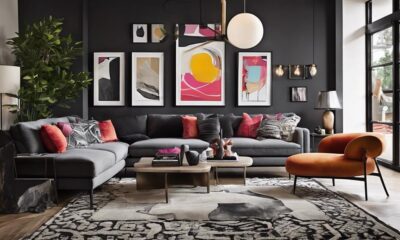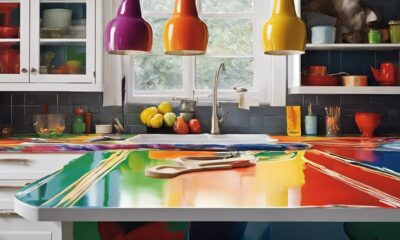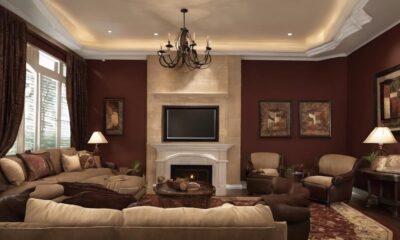Decor
How to Mix Metals in Decor
2025
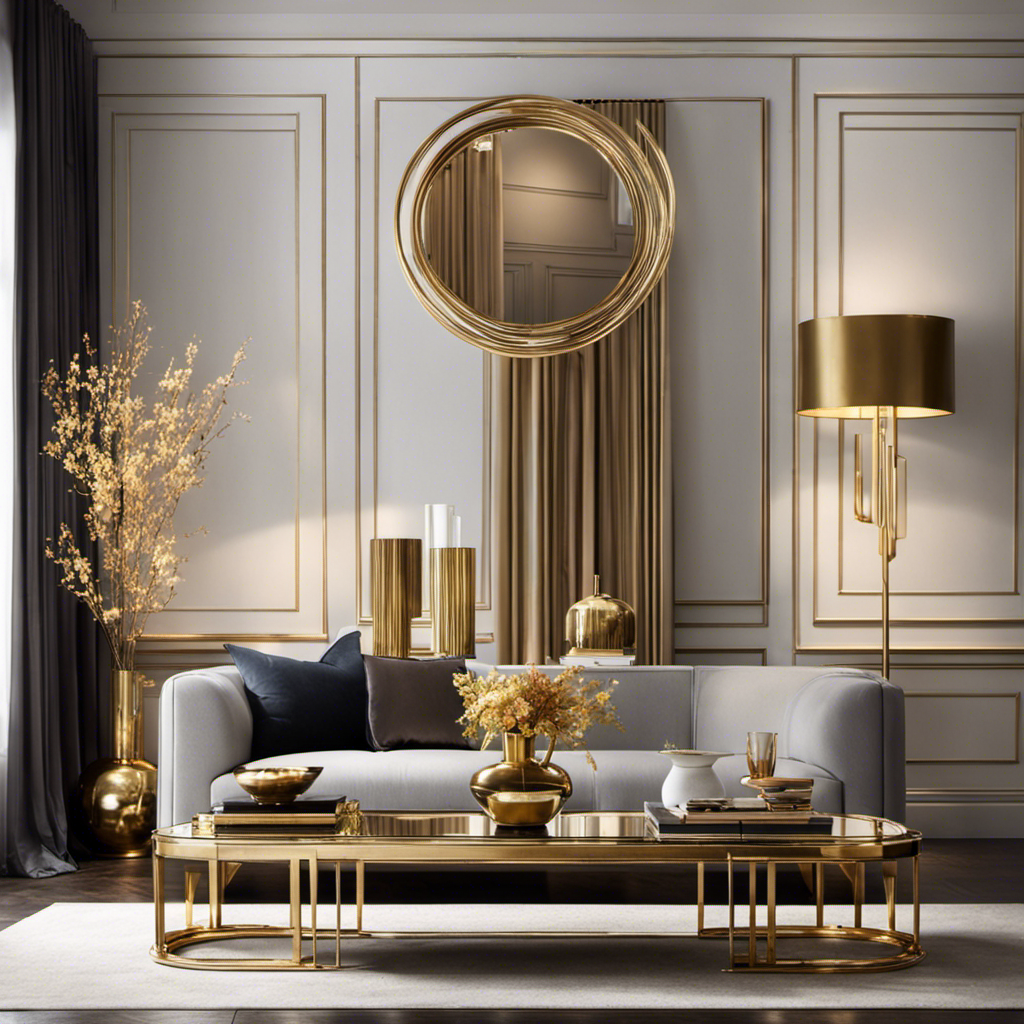
Have you ever marveled at how interior designers seamlessly blend various metals in home decor, resulting in a striking visual balance?
Mixing metals in decor is an art form that adds depth, contrast, and sophistication to any space.
By understanding metal finishes, choosing a dominant metal, and balancing warm and cool tones, you can achieve a perfectly curated look.
In this article, we will explore the secrets behind successfully blending various metals, from brushed to polished, brass to black, and even unconventional combinations.
Get ready to elevate your interior design game and create a space that truly shines.
Key Takeaways
- Different metal finishes have unique characteristics that impact the overall look and feel of a space.
- Understanding metal pairing tips is important for mixing metal finishes.
- Balancing warm and cool tones in metal mixing is important.
- Combining different metals adds depth and visual interest.
Understanding Metal Finishes
Understanding metal finishes is important when it comes to mixing metals in decor. Each metal finish has its own unique characteristics and can greatly impact the overall look and feel of your space.
When incorporating copper accents, it is crucial to understand the different finishes available. For a warm and rustic vibe, consider using an antiqued copper finish. This finish adds depth and age to your decor, giving it a vintage appeal.
If you prefer a sleek and modern look, a polished copper finish is the way to go. Its smooth and reflective surface adds a touch of elegance to any room.
By understanding these metal finishes, you can successfully incorporate copper accents into your decor, creating a cohesive and stylish space.
Now, let’s move on to choosing a dominant metal that will tie everything together seamlessly.
Choosing a Dominant Metal
When it comes to incorporating different metal finishes in your decor, it’s important to have a solid understanding of metal pairing tips and how to create visual balance.
By following these tips, you can confidently mix and match metals to create a cohesive and stylish look in your space.
From considering the undertones of each metal to strategically placing them throughout your room, you’ll be able to achieve a harmonious balance that is visually pleasing to the eye.
Metal Pairing Tips
To create a stylish and cohesive look in your decor, it’s important to know which metals pair well together. Understanding metal compatibility is key when incorporating metallic accents into your home. Here are some tips to help you achieve a harmonious mix of metals:
-
Consider the undertones: Pay attention to the warm or cool undertones of the metals you are using. Pairing warm-toned metals like gold and brass with other warm-toned metals creates a cohesive and inviting look.
-
Mix textures: Combining metals with different textures adds visual interest to your space. For example, pairing a smooth polished silver with a rough hammered copper can create a dynamic contrast.
-
Balance the proportions: When mixing metals, consider the size and scale of each piece. Aim for a balanced distribution throughout the room to avoid overwhelming one metal over another.
-
Experiment with finishes: Don’t be afraid to mix different metal finishes, such as matte, brushed, or shiny. This adds depth and dimension to your decor.
By understanding metal compatibility and following these tips for incorporating metallic accents, you can create a visually stunning and cohesive space in your home.
Now, let’s move on to creating visual balance without further ado.
Creating Visual Balance
Now that we have covered metal pairing tips, let’s explore how to achieve visual balance in your space. Balancing proportions and incorporating metallic textures are key elements in creating a harmonious and cohesive design. To help you achieve this, consider the following table:
| Metal Finish | Proportion |
|---|---|
| Brass | 30% |
| Chrome | 20% |
| Copper | 25% |
| Gold | 15% |
| Silver | 10% |
Balancing Warm and Cool Tones
It’s important to find a balance between warm and cool tones when mixing metals in decor. By incorporating copper accents, you can achieve this harmonious blend of colors. Copper has a warm undertone that pairs well with both warm and cool metals, making it the perfect bridge between the two.
For example, you can mix copper with cool silver tones to add warmth and depth to a space. Similarly, combining copper with warm gold tones can create a striking contrast that adds visual interest. Remember, the key is to strike a balance between warm and cool metals, allowing them to complement each other rather than competing for attention.
Now, let’s explore how to take your metal mixing game to the next level by layering metals with accessories.
Layering Metals With Accessories
So you’ve mastered the art of balancing warm and cool tones in your home decor, but now it’s time to take your metal mixing skills to the next level.
Combining different metals can add a unique and sophisticated touch to your space, creating a dynamic visual contrast that is sure to catch the eye.
But don’t just stop at combining metals – choosing complementary finishes is key to achieving a cohesive and polished look.
Combining Different Metals
To create a harmonious look, try combining different metals in your decor. Just like in jewelry, mixing metals can add depth and visual interest to your space. By incorporating various metals, you can create a metallic color palette that is both stylish and sophisticated. To help you get started, here’s a table showcasing different metals and their characteristics:
| Metal | Characteristics |
|---|---|
| Gold | Warm, luxurious |
| Silver | Cool, modern |
| Copper | Rustic, earthy |
| Brass | Vintage, industrial |
| Stainless Steel | Sleek, contemporary |
Choosing Complementary Finishes
When choosing complementary finishes, it’s important to consider incorporating different textures and sheens. This not only adds dimension but also creates a visually appealing space. Understanding metal compatibility is crucial in achieving a cohesive look. Mixing metals may seem intimidating, but with the right approach, it can actually elevate your decor to a whole new level.
To start, select a dominant metal that will serve as the anchor for your design. This will provide a solid foundation for your overall look. Once you have your dominant metal, choose one or two complementary metals that will add contrast and interest. For example, pairing brushed nickel with warm brass can create a modern yet inviting ambiance.
Don’t be afraid to experiment and mix different finishes. Combining polished chrome with antique bronze, for instance, can result in a unique and eclectic look. By combining metals with varying textures and sheens, you can create a visually dynamic space that will captivate and inspire.
Transitioning into the next section, let’s explore how to create visual interest through strategic placement of metal accents.
Creating Visual Interest
Now that you’ve learned about choosing complementary finishes for your mixed metal decor, let’s move on to creating visual interest. Balancing different textures is key to achieving a captivating and dynamic look. Think about incorporating a variety of textures such as smooth, rough, shiny, and matte. This can be done through the use of different metal finishes, but also by incorporating other materials like wood, glass, or fabric. To help you visualize the possibilities, here’s a table showcasing three different ways to balance textures in your decor:
| Textures | Examples |
|---|---|
| Smooth and shiny | Polished brass lamp |
| Rough and matte | Hammered copper bowl |
| Soft and tactile | Velvet cushions |
In addition to texture, incorporating metallic artwork can add a touch of elegance and sophistication to your space. Hang a statement piece of artwork featuring brushed or polished metals to create a focal point that draws the eye. This will complement the mixed metal elements in your decor and tie everything together seamlessly.
Next, we’ll explore the art of mixing brushed and polished metals…
Mixing Brushed and Polished Metals
You can create a stylish and modern look by mixing brushed and polished metals in your decor. Balancing shiny and matte finishes adds depth and visual interest to any space. Here are four ways to incorporate this trend into your home:
-
Furniture: Choose pieces that combine both brushed and polished metal accents, such as a coffee table with a brushed metal frame and polished metal legs.
-
Lighting: Opt for pendant lights or chandeliers that feature a combination of brushed and polished metal finishes. This will create a captivating focal point in any room.
-
Accessories: Add smaller touches of mixed metals through accessories like picture frames, vases, or candle holders. This will bring a cohesive look to your decor.
-
Hardware: Update your cabinet handles and drawer pulls with a mix of brushed and polished metal finishes. This subtle detail will elevate the overall look of your space.
By incorporating a mix of brushed and polished metals, you can achieve a contemporary and sophisticated aesthetic.
Now, let’s explore how to incorporate copper accents into your decor seamlessly.
Incorporating Copper Accents
So, you’ve decided to incorporate copper accents into your home decor. Well, let’s talk about why copper is a standout choice compared to other metals.
Not only does copper add warmth and richness to a space, but it also has a unique ability to patina and age beautifully over time.
Now, let’s explore how to strike the perfect balance when using copper accents, so your space doesn’t feel overwhelming. By combining copper with other metals like brass or nickel, you can create a layered and visually interesting look.
Lastly, let’s dive into some styling tips for incorporating copper into your decor. From adding copper light fixtures to accessorizing with copper planters or artwork, there are countless ways to infuse this versatile metal into your space and make a statement.
Copper Vs Other Metals
When mixing metals in decor, it’s important to consider the contrasting properties of copper and other metals. Copper has been a popular choice in recent years, with copper trends showing no signs of slowing down. Its warm, reddish-brown hue adds a touch of elegance and sophistication to any space. Copper accessories, such as vases, lamps, and candle holders, can instantly elevate the look of a room. However, when mixing copper with other metals, it’s crucial to strike a balance between the different elements. To help you understand the contrasting properties of copper and other metals, here is a comparison table:
| Copper | Other Metals |
|---|---|
| Warm | Cool |
| Shiny | Matte |
| Malleable | Rigid |
Balancing Copper Accents
To achieve a visually appealing mix of metals, it’s essential to strike a balance with copper accents. Copper color schemes are a popular choice in interior design, adding warmth and elegance to any space. But how can you incorporate copper in outdoor decor without overwhelming the overall look?
One way is to use copper in smaller, accent pieces, such as planters, lanterns, or decorative objects. These touches of copper will add a touch of sophistication to your outdoor space without overpowering it.
Another option is to combine copper with other metals, such as stainless steel or wrought iron, creating a harmonious blend of textures and finishes. By carefully selecting and placing copper accents, you can create a cohesive and stylish outdoor space that showcases the beauty of this versatile metal.
Now, let’s dive into the world of styling with copper.
Styling With Copper
One great way to incorporate copper into your interior design is by using it as a statement piece in your lighting fixtures.
Copper color schemes can add warmth, depth, and a touch of elegance to any room.
The benefits of using copper go beyond its stunning appearance. Copper is a highly durable material that is resistant to corrosion, making it a long-lasting choice for your lighting fixtures. Its natural antimicrobial properties also make it a hygienic option for your home.
Moreover, copper has the ability to beautifully age over time, developing a unique patina that adds character and charm to your space.
Pairing Gold and Silver
It’s important to consider the balance between gold and silver when mixing metals in decor. Gold and silver can create a stunning combination that adds sophistication and elegance to any space. When pairing rose gold and platinum, you can create a luxurious and modern look. The warm tones of rose gold complement the cool tones of platinum, creating a beautiful contrast. On the other hand, mixing antique gold and stainless steel can create a more eclectic and rustic feel. The aged look of the antique gold pairs well with the sleek and contemporary stainless steel. To help you visualize the possibilities, here is a table showcasing different ways to combine gold and silver in your decor:
| Gold | Silver |
|---|---|
| Rose Gold | Platinum |
| Antique Gold | Stainless Steel |
Now, let’s transition into exploring the beauty of brass in our next section.
Exploring the Beauty of Brass
Brass adds a touch of elegance and warmth to any space. Its beautiful golden hue and versatile nature make it a popular choice for interior design. Here are three reasons why exploring brass patinas and incorporating brass in kitchen design can elevate your home decor:
-
Timeless Beauty: Brass develops a rich patina over time, adding character and depth to your space. From antique finishes to brushed or polished options, brass offers a range of looks for every style.
-
Kitchen Brilliance: Brass hardware, faucets, and lighting fixtures can transform your kitchen into a sophisticated culinary haven. The warm tones of brass create a welcoming atmosphere, while its durability ensures long-lasting beauty.
-
Mix and Match: Brass effortlessly pairs with other metals, allowing you to experiment with different combinations. Whether you choose to mix brass with silver, gold, or even copper, the result is a dynamic and visually appealing space.
Now, let’s delve into the art of mixing metals in lighting fixtures without skipping a beat.
Mixing Metals in Lighting Fixtures
Why not try experimenting with different combinations of metals to create a visually stunning and dynamic space in your home? Mixing metals in furniture and incorporating metal accents in home decor can add a touch of elegance and sophistication to any room.
When it comes to lighting fixtures, this is where you can truly let your creativity shine. Imagine a pendant light with a combination of brass and copper, or a chandelier with a mix of silver and gold. The possibilities are endless! By mixing metals in your lighting fixtures, you can create a unique and eye-catching focal point in your space.
Creating Contrast With Black Metal
To create a striking and dramatic look in your space, you can’t go wrong with incorporating black metal accents into your lighting fixtures. Black metal adds a touch of sophistication and elegance, while also creating a bold contrast against other materials.
Here are a few ways you can achieve this stunning look:
-
Pair black metal pendant lights with wooden furniture to create a beautiful contrast between the sleekness of the metal and the warmth of the wood.
-
Install black metal sconces on a wooden accent wall to create a visually striking focal point in your room.
By incorporating black metal accents, you can effortlessly create a modern and edgy aesthetic that complements any decor style.
Now, let’s dive into the exciting world of experimenting with unconventional metal combinations.
Experimenting With Unconventional Metal Combinations
Now that you’ve learned how to create contrast with black metal, it’s time to take your metal mixing skills to the next level by experimenting with unconventional metal combinations. This is where you can truly let your creativity shine by incorporating unexpected materials into your decor.
To help you get started, here’s a handy table showcasing some bold combinations that you can try:
| Metal 1 | Metal 2 |
|---|---|
| Copper | Stainless Steel |
| Brass | Iron |
| Aluminum | Bronze |
| Gold | Nickel |
| Silver | Zinc |
By combining different metals, you can add visual interest and depth to any space. Imagine a copper and stainless steel pendant light hanging above a brass and iron side table. The possibilities are endless!
So go ahead and embrace your adventurous side. Don’t be afraid to mix and match metals to create a unique and captivating decor that will leave your guests in awe. Experiment with contrasting finishes, like pairing matte black with polished gold, to add depth and character to your space. Incorporating statement pieces, like wrought iron wall art, can also serve as a focal point that ties the entire design together. For those looking to highlight this timeless material, researching wrought iron wall decor buying tips will ensure you select pieces that are both high-quality and perfectly suited to your aesthetic.
Frequently Asked Questions
Can I Mix Different Metal Finishes in the Same Room?
Yes, you can mix different metal finishes in the same room. It adds visual interest and a modern, eclectic touch to your decor. Consider incorporating mixed metals in kitchen decor and bathroom design for a cohesive look.
How Do I Incorporate Rose Gold Into a Mixed Metal Decor?
To incorporate rose gold into your mixed metal decor, start by choosing a contemporary style. Mix rose gold accents with other metals like silver and brass for a chic and elegant look.
Are There Any Rules for Mixing Metals in Small Spaces?
When it comes to mixing metals in kitchen decor and balancing warm and cool metal tones in a small space, there are no hard rules. Get creative, pay attention to detail, and let your knowledge guide you.
Can I Mix Metals in Outdoor Decor?
Can you mix metals in outdoor decor? Mixing metals in outdoor furniture can add visual interest and create a unique, eclectic look. However, be mindful of the different metal finishes to ensure they complement each other.
What Are Some Tips for Incorporating Mixed Metals in a Minimalist Design?
To incorporate mixed metals in a minimalist design, start by choosing the right metal combinations. Then, balance the metal finishes with other elements in the room. This creates a stylish, contemporary look that is both sleek and eye-catching.
Conclusion
So there you have it, a comprehensive guide on how to mix metals in decor. By understanding metal finishes, choosing a dominant metal, and balancing warm and cool tones, you can create a stunning and harmonious space.
One interesting statistic to note is that according to a recent survey, 80% of interior designers believe that mixing metals adds depth and visual interest to a room.
So don’t be afraid to experiment with different metal combinations and create a unique and personalized space that reflects your style and personality.
Happy decorating!
- About the Author
- Latest Posts
Introducing Ron, the home decor aficionado at ByRetreat, whose passion for creating beautiful and inviting spaces is at the heart of his work. With his deep knowledge of home decor and his innate sense of style, Ron brings a wealth of expertise and a keen eye for detail to the ByRetreat team.
Ron’s love for home decor goes beyond aesthetics; he understands that our surroundings play a significant role in our overall well-being and productivity. With this in mind, Ron is dedicated to transforming remote workspaces into havens of comfort, functionality, and beauty.
Architecture Home Styles
How to Build a Traditional Balinese House: What Is It Called?
Discover the enigmatic term that embodies the essence of a traditional Balinese home – a secret word starting with 'B' awaits your curiosity.

Let’s dive into the exploration of the complex process of building a traditional Balinese house, imagining the careful arrangement of each architectural element, reflecting a harmonious interplay between earthly elements and celestial influences.
But have you ever wondered, amidst the symphony of architectural poetry, what is the term used to encapsulate the essence of this sacred dwelling?
Join us as we uncover the cultural identity and philosophical underpinnings behind the name that encapsulates the soul of a traditional Balinese home.
Key Takeaways
- A traditional Balinese house is called a 'kuren' and embodies practicality and spirituality.
- Components like granary, kitchen, and protective walls are crucial in its layout.
- The design reflects Balinese spirituality, cultural identity, and reverence for ancestors.
- Strategic placement of key elements and house shrines enhance the spiritual significance of the house.
Overview of Traditional Balinese House
In exploring the essence of a traditional Balinese house, we delve into the intricate tapestry of cultural significance woven into every architectural detail. The traditional Balinese house, also known as 'kuren,' embodies a harmonious blend of practicality and spirituality within its compound, reflecting the rich heritage of Balinese architecture.
At the heart of this architectural masterpiece lies the family temple, a sacred space where daily offerings and prayers are conducted to honor ancestors and seek blessings for the household. The layout of a traditional Balinese house, meticulously designed following ancient Hindu manuscripts and local customs, comprises essential components such as the sleeping pavilion, kitchen, ceremonial pavilion, and guest pavilion.
The 'bale,' or pavilions, serve distinct purposes, with each designated for specific activities like sleeping, dining, or hosting guests. Additionally, features like the granary, kitchen, and protective walls play crucial roles in both daily life and ceremonial functions, underscoring the deep-rooted cultural beliefs embedded in every architectural element of a traditional Balinese house.
Cultural Significance of 'Rumah Adat
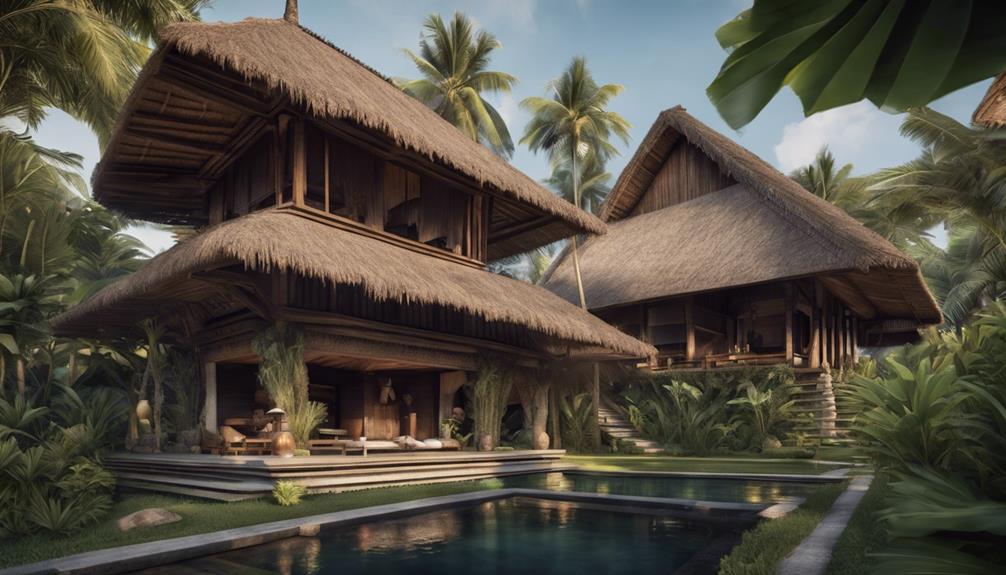
When examining the cultural significance of 'Rumah Adat', we uncover a deep-rooted connection to Bali's historical traditions and spiritual beliefs.
The symbolism embedded in the architecture of these houses serves as a visual representation of Balinese spirituality and cultural identity.
Additionally, the communal gathering spaces within 'Rumah Adat' play a vital role in fostering community bonds and upholding age-old customs.
Historical Roots of 'Rumah Adat
Exploring the genesis of 'Rumah Adat' delves into the rich tapestry of Balinese cultural heritage, intricately weaving together ancient Hindu manuscripts and local customs to shape the essence of traditional Balinese houses. The historical roots of 'Rumah Adat' are deeply embedded in the spiritual and cultural fabric of Balinese society, reflecting a harmonious blend of tradition and belief systems. These houses serve as tangible expressions of the Balinese people's reverence for their ancestors and the divine. The intricate architectural details, such as the layout and spatial organization, are a testament to the historical significance of 'Rumah Adat.' Below is a table showcasing some components and their functions within these traditional Balinese houses:
| Component | Function |
|---|---|
| Granaries | Storage of rice and important crops |
| Kitchens | Preparation of ceremonial offerings |
| Walls | Protection and delineation of space |
Symbolism in Architecture
The intricate architecture of a traditional Balinese house, known as 'Rumah Adat,' encapsulates the profound cultural symbolism and spiritual significance ingrained in Balinese society. The placement of structures like the Bale Daja, the design of house shrines, and adherence to principles like Tri Hita Karana and Asta Kosala Kosali all contribute to the symbolic richness of Balinese house architecture.
The Bale Daja, positioned in the northeast corner, signifies the highest spiritual and social status within the family. House shrines, such as the family temple or Meru tower, represent connections to ancestral spirits and gods. The principles of Tri Hita Karana emphasize harmony with people, nature, and the divine, while Asta Kosala Kosali govern architectural proportions and layouts, reflecting the balance between the physical and spiritual worlds.
Community Gathering Spaces
Nestled amidst the lush landscapes of Bali, the 'Rumah Adat' stands as a revered communal space pulsating with cultural activities and shared traditions. Serving as a sacred place, the 'Rumah Adat' isn't merely a physical structure but a symbol of community unity and cultural heritage.
Within its walls, the open pavilion serves as a meeting hall for ceremonies, social gatherings, and storytelling sessions, fostering the exchange of traditional knowledge and practices. Balinese temples often find their place within these traditional houses, enhancing the spiritual significance of the space.
The design and layout of the 'Rumah Adat' reflect the values and beliefs of the Balinese people, emphasizing the importance of community bonds and the preservation of cultural identity.
Architectural Elements and Design
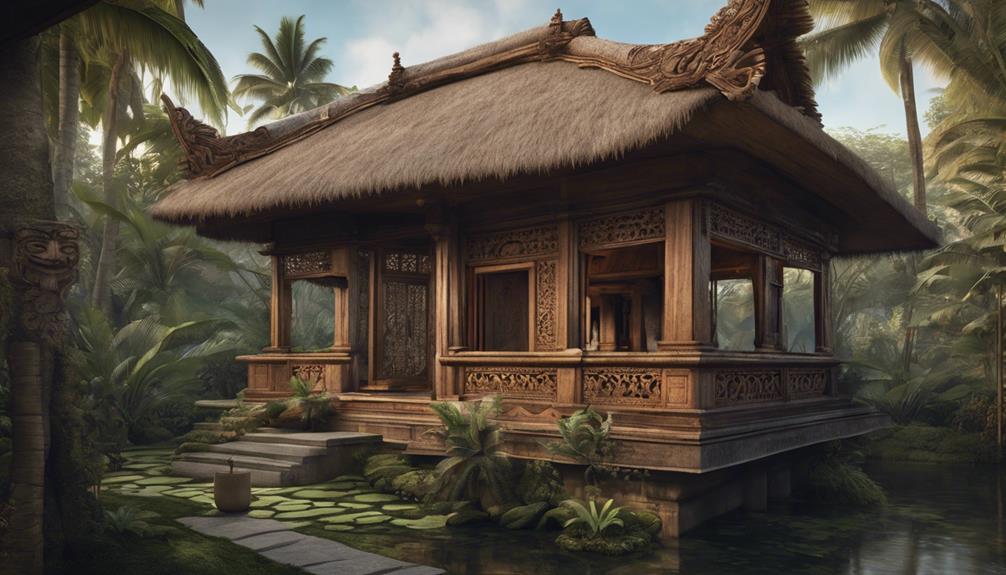
In Balinese traditional house architecture, the design incorporates essential elements such as Sanggah Kemulan for ancestral worship and Bale Daja for living quarters, following specific principles rooted in ancient Hindu manuscripts and local customs. The layout of a Balinese house compound is meticulously planned to symbolize the cosmos, with each building mass positioned according to its function and significance.
To provide a clearer picture, consider the following key elements within a traditional Balinese house:
- Bale Dangin: Located on the east side, this area serves as a space for receiving guests and important ceremonies.
- Meten: Positioned on the north side, the Meten is a transitional space connecting different parts of the house.
- Sanggah Kemulan: This sacred space is dedicated to ancestral worship and is situated in a strategic location within the compound.
- Lumbung: A unique feature found in southern Bali, the lumbung serves as a rice barn, highlighting the agricultural roots of Balinese culture.
Spatial Arrangement:
The spatial arrangement within Balinese traditional houses reflects a deep connection to religious beliefs and cosmological principles, creating a harmonious environment for its inhabitants.
Construction Process and Techniques
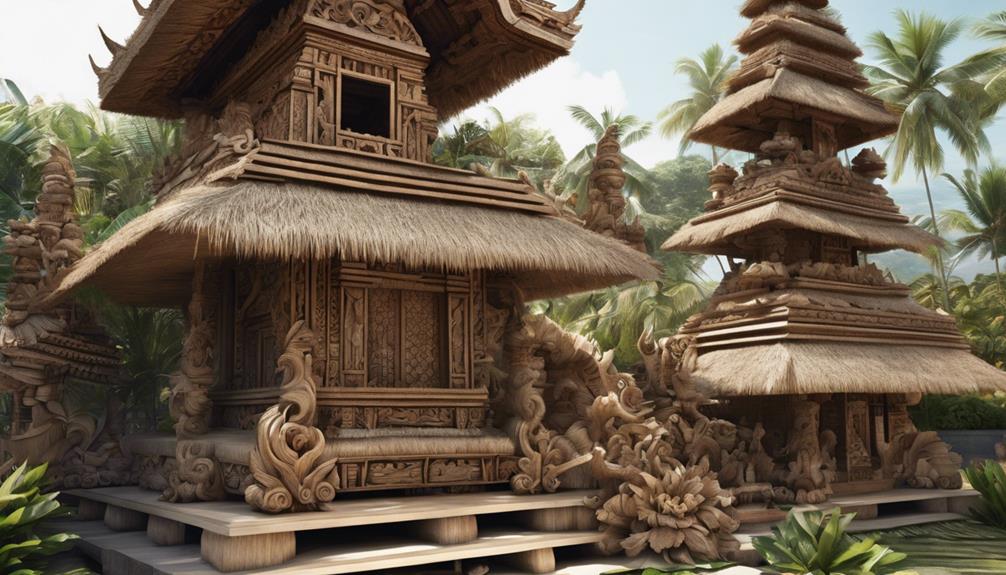
As we progress to explore the construction process and techniques of traditional Balinese houses, we delve into the intricate use of organic materials like bamboo, coconut wood, and stone.
Thatched roofs play a crucial role, utilizing materials such as ijuk fibers and dried coconut leaves for roofing techniques.
The layout design follows ancient Hindu architectural principles, showcasing the meticulous attention to cultural and spiritual significance in Balinese architecture.
Materials Used
Thatch roofing materials like ijuk fibers, dried coconut leaves, or sirap shingles play a crucial role in the construction of traditional Balinese houses, reflecting the intricate craftsmanship and sustainable practices embedded in Balinese architecture.
These materials are just the beginning; bamboo poles and coconut wood form the essential framework, while stone foundations and walls made of red bricks, sandstone, and andesite stone ensure durability.
Teak wood, known for its elegance and longevity, is a popular choice for both interior and exterior features. Balinese houses aren't just structures; they're pieces of art.
Artistic ornamentation, including floral patterns and sculptures of gate guardians or water spouts, adorns these houses, showcasing the deep cultural and spiritual influences that shape Balinese design.
Roofing Techniques
Embracing the rich heritage of Balinese architecture, the construction of traditional Balinese house roofs involves a meticulous process that highlights skilled craftsmanship and a deep connection to nature. Thatching techniques are central to the roofing process, with organic materials like ijuk fibers, dried coconut leaves, or sirap hardwood shingles carefully layered and secured to create a waterproof and durable roof structure. The emphasis on using natural materials ensures harmony with the environment and traditional architectural aesthetics. Balinese roof construction prioritizes proper insulation, ventilation, and protection from the elements, showcasing the intricate knowledge passed down through generations. Different regions in Bali have varying roof designs, with techniques and materials tailored to suit local climate conditions and cultural preferences.
| Balinese traditional house | Roofing Techniques |
|---|---|
| Organic materials | Thatching techniques |
| Skilled craftsmanship | Proper insulation |
| Natural aesthetics | Regional variations |
Layout Design
In crafting the layout design of a traditional Balinese house, adherence to ancient Hindu manuscripts like Lontar Asta Kosala Kosali guides the strategic placement of key elements within the compound. Considerations include positioning the family temple towards the north or east to face the mountain and sunrise.
Specific layout design dictates where the living quarters, kitchen, and animal housing should be situated within the compound. Pavilions such as Sakapat with 4 columns and Sekutus with 8 columns are incorporated for various activities.
Waste management areas, known as Teba, are traditionally located at the back of the courtyard. This meticulous arrangement creates a harmonious living space that reflects both cultural significance and practical functionality.
Importance of Spiritual Spaces
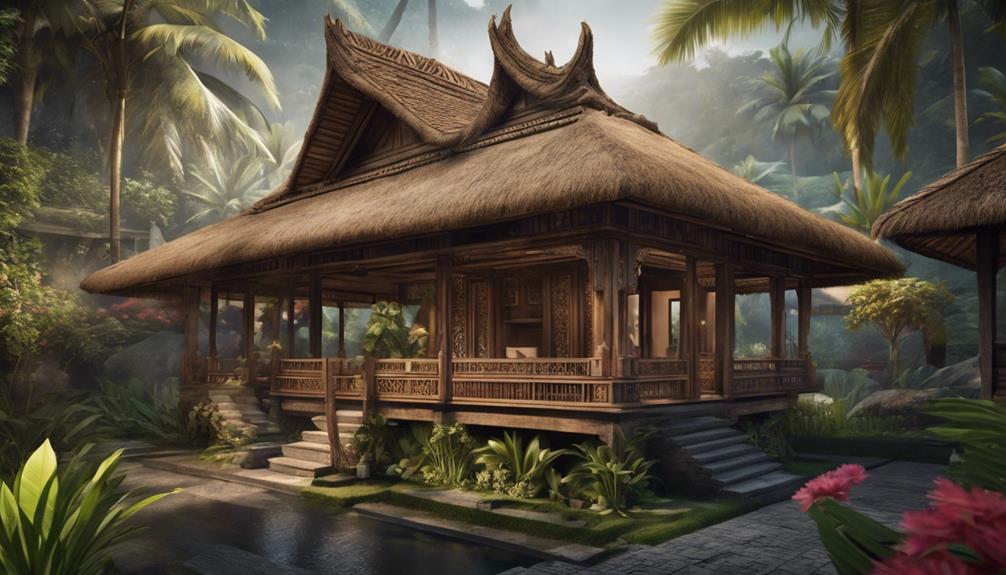
Spiritual spaces within traditional Balinese houses, such as the family temple (Sanggah), play a fundamental role in daily offerings and prayers, emphasizing the deep-rooted connection between the physical and spiritual realms.
Positioned thoughtfully within the compound to face sacred mountains and the sunrise, these spaces symbolize the Balinese people's belief in maintaining a harmonious relationship with nature and the divine.
The meticulous design and orientation of these areas reflect a cultural reverence for spiritual practices, showcasing the importance of religious rituals in everyday life.
The presence of these spiritual spaces serves as a constant reminder of the profound spiritual beliefs and practices that are ingrained in the Balinese way of life.
Through these sacred areas, Balinese houses become more than just physical structures; they become vessels of tradition and spirituality, fostering a sense of peace and connection with the spiritual world for those who inhabit them.
Maintenance and Preservation Tips
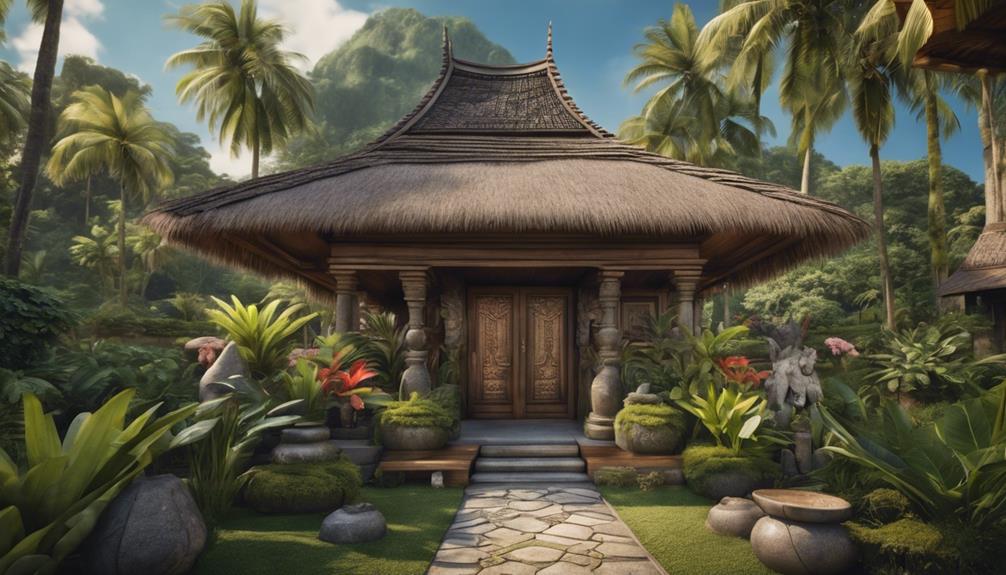
Moving from the realm of spiritual spaces to the realm of practicality and care, maintaining and preserving a traditional Balinese house requires diligent attention to various elements that uphold its cultural significance and structural integrity.
When it comes to maintenance and preservation in Balinese style traditional houses, there are specific tips to keep in mind:
- Regularly inspect and repair thatched roofs made of materials like ijuk fibers or dried coconut leaves to maintain their integrity and prevent leaks.
- Apply protective coatings or treatments to organic materials like bamboo and coconut wood to prevent decay and extend their lifespan.
- Use traditional methods like whitewashing mud walls to protect them from weathering and maintain their structural integrity over time.
- Conduct routine checks on stone and brick foundations for any signs of erosion or damage, repairing them promptly to ensure the stability of the house.
- Preserve and restore intricate artistic ornamentation and sculptures depicting cultural symbols to maintain the aesthetic and cultural value of the traditional Balinese house.
Frequently Asked Questions
What Is a Traditional Balinese House Called?
When we talk about a traditional Balinese house, we refer to it as a 'kuren' or 'rumah adat Bali' in Indonesian. This term describes a family compound enclosed by a whitewashed mud wall in Bali.
These houses are made up of various pavilions with specific functions within the compound. Their design is deeply rooted in ancient Hindu manuscripts and local customs, each component carrying cultural and spiritual significance in Balinese tradition.
What Is Traditional Balinese House Architecture?
Traditional Balinese house architecture represents a harmonious blend of spiritual beliefs and cultural practices. These houses are designed with distinct pavilions like Sanggah Kemulan, Bale Daja, and Bale Dangin within walled compounds, following ancient Hindu manuscripts. Each pavilion holds a specific purpose, reflecting the balance between the human, natural, and divine realms, which is central to Balinese philosophy. The layout ensures a sacred alignment with Mount Agung, considered the spiritual axis of the island. For modern adaptations, incorporating japandi living room furniture tips can help blend traditional aesthetics with minimalist Scandinavian designs, creating a serene and functional living space.
The layout, guided by the Tri Angga concept, emphasizes a hierarchy of spaces and materials, symbolizing cosmological conceptions. This design not only reflects the territory and orientation but also plays a crucial role in daily and ceremonial activities.
What Is the Structure of a Bali House?
The structure of a Bali house is a rich tapestry of cultural and spiritual significance. Each pavilion symbolizes a distinct aspect of Balinese life, from the family temple to the ceremonial pavilion.
The layout follows ancient design principles, reflecting the harmony between practicality and spirituality. As we explore the microcosm of the universe within the compound, we discover a world where spatial arrangements mirror cultural hierarchies and orientations, creating a unique architectural blend.
What Is Vernacular Architecture in Bali?
In Bali, vernacular architecture embodies the essence of indigenous design, drawing on organic materials like thatch, bamboo, stone, and wood. It's a fusion of intricate details, ornamental flair, and rich cultural symbolism.
Reflecting the local climate, environment, and Balinese lifestyle, this architecture is deeply intertwined with spiritual beliefs and historical influences. It captures a unique blend of tradition and innovation, creating structures that resonate with the soul of the Balinese people.
Conclusion
As we witness the intricate construction of a traditional Balinese house, we're transported to a realm where spirituality intertwines with architectural design.
The harmony of the Tri Hita Karana philosophy is palpable in every corner, reflecting a deep connection with the natural and spiritual world.
Through the preservation of these cultural treasures, we ensure that the legacy of 'Rumah Adat' continues to stand as a testament to Balinese heritage and wisdom.
- About the Author
- Latest Posts
Introducing Ron, the home decor aficionado at ByRetreat, whose passion for creating beautiful and inviting spaces is at the heart of his work. With his deep knowledge of home decor and his innate sense of style, Ron brings a wealth of expertise and a keen eye for detail to the ByRetreat team.
Ron’s love for home decor goes beyond aesthetics; he understands that our surroundings play a significant role in our overall well-being and productivity. With this in mind, Ron is dedicated to transforming remote workspaces into havens of comfort, functionality, and beauty.
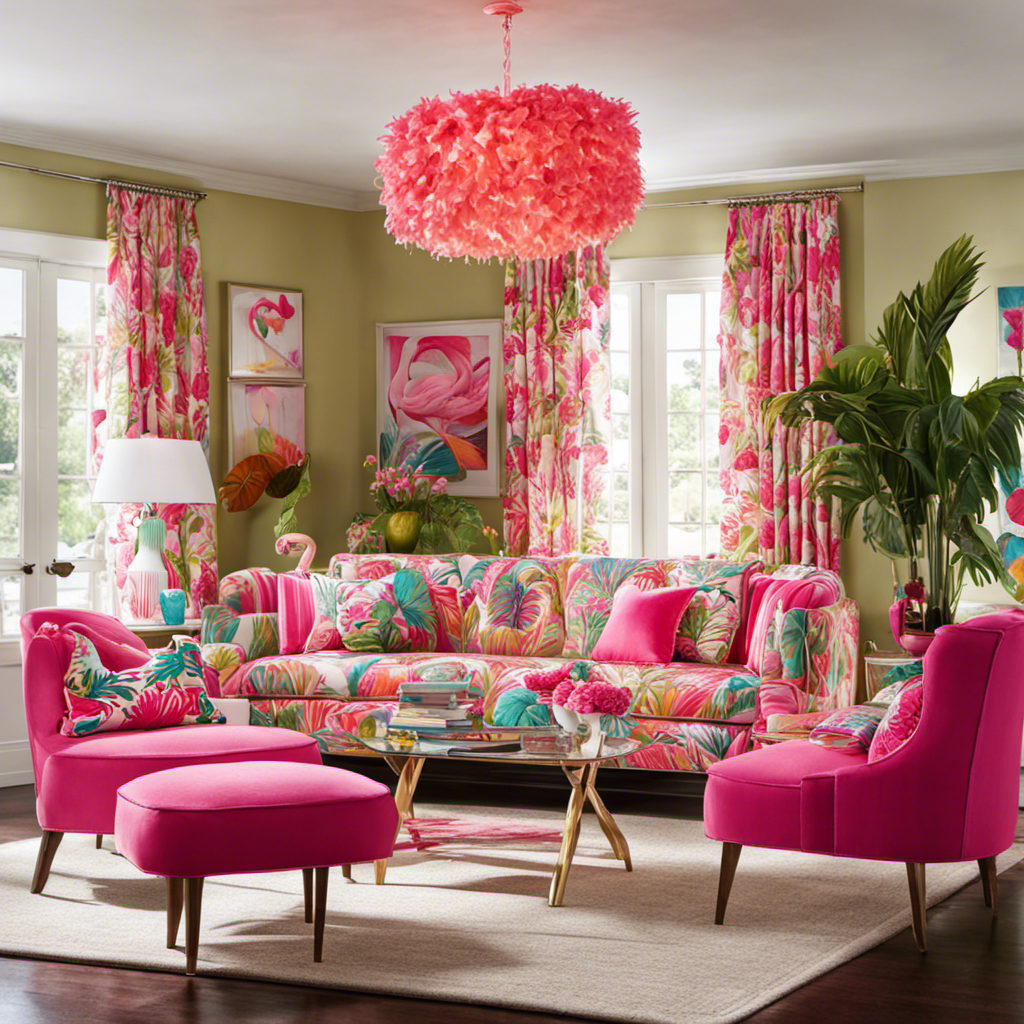
Upon entering my friend’s living room, I was immediately drawn to the striking flamingo decorations that adorned the space. The vibrant hues and elegant shapes captivated me right away. This left me pondering, what significance does this flamingo decor hold?
Translated text in English (United States): As I entered my friend’s living room, I couldn’t help but notice the stunning flamingo decor adorning the space. The vibrant colors and graceful forms instantly caught my attention. Intrigued, I began to wonder, what does this flamingo decor mean?
In this article, we will explore the symbolism, historical significance, and cultural meaning behind flamingo decor. We will also delve into how it is utilized in interior design, art, and fashion, as well as its significance in different cultures.
Join me on this journey to unravel the hidden depths of flamingo decor and its personal expression.
Key Takeaways
- Flamingo decor is associated with elegance, gracefulness, and beauty.
- Flamingos symbolize beauty, balance, and the divine.
- Flamingo decor reflects their cultural symbolism in homes and everyday lives.
- Flamingo decor adds a playful and tropical touch to any interior design.
Symbolism of Flamingo Decor
Flamingo decor is often associated with elegance and gracefulness. The historical origins of this popular motif can be traced back to ancient civilizations such as Egypt and Rome, where flamingos were admired for their beauty and unique appearance. These birds were often depicted in art and architecture, symbolizing beauty, balance, and the divine.
In modern times, flamingo decor has gained widespread popularity due to its vibrant and eye-catching nature, making it a perfect choice for adding a touch of whimsy and sophistication to any space. Beyond its aesthetic appeal, flamingo decor also holds psychological significance. The graceful stance and vibrant colors of the flamingo can evoke feelings of joy, positivity, and a sense of freedom. It is a symbol of resilience and adaptability, reminding us to stay strong and flexible in the face of challenges.
As we explore the historical significance of flamingo decor, we will uncover the fascinating stories and cultural meanings associated with this beloved motif.
Historical Significance of Flamingo Decor
As an avid enthusiast of decorative art, I find the cultural symbolism of flamingos to be a fascinating subject.
Not only do these majestic birds represent grace and elegance, but they also hold a deeper meaning in various cultures around the world.
Exploring the evolution of flamingo decor throughout history and its incorporation into different art forms provides insight into the way these vibrant creatures have captivated human imagination and creativity.
From ancient civilizations to modern art movements, the presence of flamingo decor has left a lasting impression on our visual culture, making it a truly captivating topic to delve into.
Cultural Symbolism of Flamingos
The cultural symbolism of flamingos can be seen in various art forms and traditions around the world. These elegant birds have a deep symbolic meaning and cultural significance that has been celebrated for centuries.
Here are some examples of how flamingos are represented in different cultures:
- In ancient Egypt, flamingos were associated with the god Ra and were seen as a symbol of the sun and resurrection.
- In Caribbean cultures, flamingos represent beauty, grace, and the vibrant colors of the tropics.
Flamingos have also been featured in various art forms, such as paintings, sculptures, and textiles, showcasing their allure and mystique. Their long, slender necks and vibrant pink feathers make them a popular subject for artists. These representations not only highlight the beauty of the birds but also capture the essence of their symbolic meaning and cultural significance.
As we delve into the evolution of flamingo decor, we can see how their cultural symbolism has influenced the way they are portrayed in our homes and everyday lives.
Evolution of Flamingo Decor
Throughout the years, flamingo decor has become increasingly popular, adding a touch of elegance and whimsy to homes and spaces.
But what is it about flamingos that captivate us? These unique creatures have evolved incredible adaptations to survive in their natural habitats, which has had an ecological impact on the ecosystems they inhabit.
From their long, slender legs that allow them to wade through shallow waters, to their curved beaks that filter tiny organisms from the water, flamingos are truly remarkable. Their vibrant pink plumage, a result of their diet rich in shrimp and algae, adds to their allure.
This combination of evolutionary adaptations and ecological impact has inspired artists to incorporate flamingos into their artwork, creating stunning pieces that capture the beauty and grace of these magnificent birds.
It is through art that the magic of flamingo decor truly comes to life.
Flamingo Decor in Art
Flamingo decor has become increasingly popular in art, capturing the beauty and grace of these magnificent birds. The symbolism in flamingo art is rich and diverse, with artists using various techniques to portray the essence of these creatures.
Here are a few artistic representations of flamingos:
-
Realistic portrayals: Some artists focus on capturing the intricate details of flamingos, from their long, slender legs to their vibrant pink feathers. These artworks aim to showcase the natural beauty and elegance of these birds.
-
Abstract interpretations: Other artists take a more creative approach, using bold colors and abstract shapes to represent flamingos. These artworks often evoke a sense of energy and movement, reflecting the dynamic nature of these birds.
Flamingo decor in art goes beyond mere aesthetics; it carries cultural and symbolic significance. Transitioning into the subsequent section, let’s explore the cultural meaning of flamingo decor and its impact on society.
Cultural Meaning of Flamingo Decor
When it comes to the symbolism of flamingos, their elegant and graceful nature often represents beauty, balance, and grace.
Flamingo decor has its origins in the 1950s, particularly in the mid-century modern design movement, where it became synonymous with tropical and beach-themed aesthetics.
However, flamingos are not limited to Western cultures alone; they hold significance in various cultures around the world. In some cultures, flamingos represent love, passion, and fertility. In others, they symbolize balance, adaptability, and resilience.
Symbolism of Flamingos
The symbolism of flamingos can be seen in various cultures and represents grace and beauty. Flamingos have captivated people’s imagination for centuries, and their significance goes beyond their vibrant pink feathers. Here are some key aspects of the symbolism of flamingos:
- In ancient Egyptian culture, flamingos were associated with the god Ra, the sun god, representing the rising and setting of the sun.
- In Native American cultures, flamingos were seen as symbols of balance and harmony with nature.
- Flamingos are often depicted in art and literature as graceful creatures, embodying elegance and poise.
- They are also seen as symbols of love and affection, as they mate for life and are devoted to their partners.
Understanding the cultural significance and symbolism of flamingos adds depth to the appreciation of these majestic birds. It sets the stage for exploring the origins of flamingo decor and the reasons why it has become a popular design choice in many households.
Flamingo Decor Origins
Understanding the cultural significance and symbolism of these birds adds depth to the appreciation of their origins in decor. Flamingo decor has become a popular trend in home design, especially in contemporary styles. These majestic creatures bring a sense of elegance and grace to any space, while also adding a touch of whimsy.
The origins of flamingo decor can be traced back to the 1950s, when the iconic pink flamingo lawn ornaments gained popularity. Since then, flamingos have become a symbol of tropical paradise and exotic destinations. Incorporating flamingo decor into contemporary design allows for a fun and vibrant atmosphere, reminiscent of sunny beaches and lush landscapes.
But what about flamingos in different cultures? Let’s delve into their significance around the world.
Flamingos in Different Cultures?
Flamingos can be found in various cultural contexts, each highlighting their unique symbolism and significance. In folklore, flamingos often represent grace, elegance, and beauty. They are seen as majestic creatures that embody the qualities of love and devotion. In some cultures, flamingos are believed to bring good luck and prosperity. Their vibrant pink color is also associated with femininity and sensuality.
Flamingo decorations hold cultural significance in many societies. They are often used to enhance the aesthetic appeal of spaces, adding a touch of whimsy and playfulness. In addition, they can serve as a symbol of tropical paradise, evoking feelings of relaxation and escape. With their long legs and graceful stance, flamingos are a popular choice in interior design, creating a sense of elegance and sophistication.
This transition into the subsequent section about ‘flamingo decor in interior design’ showcases the versatility and appeal of these fascinating creatures.
Flamingo Decor in Interior Design
Flamingo decor can add a playful and tropical touch to any interior design. In modern design, flamingo decor has become increasingly popular as a way to incorporate vibrant colors and bold patterns. From throw pillows to wall art, there are countless options to choose from to incorporate flamingo decor into your home.
In children’s rooms, flamingo decor can create a whimsical and imaginative atmosphere. Brightly colored bedding, wall decals, and even flamingo-shaped furniture can transform a child’s room into a magical oasis.
Flamingo decor in interior design is all about embracing a fun and lighthearted aesthetic that brings the beauty of nature indoors.
Now let’s dive into the next section and explore how flamingo decor is making waves in art and fashion.
Flamingo Decor in Art and Fashion
If you’re looking to add a touch of whimsy to your wardrobe or artwork, consider incorporating flamingo decor. It’s a fun and vibrant choice that has become increasingly popular in recent years, both in fashion and home decor. Flamingo decor adds a playful and tropical element to any outfit and can be incorporated through clothing, accessories, and even shoes. In home decor, it creates a bold and eye-catching statement in any room, evoking a sense of relaxation and vacation vibes. By incorporating flamingo decor into your fashion choices or home decor, you’ll instantly infuse a sense of fun and vibrancy into your surroundings. Now, let’s explore the psychological impact of flamingo decor.
Psychological Impact of Flamingo Decor
When it comes to flamingo decor, there is more than meets the eye. Symbolically, flamingos are often associated with grace, elegance, and beauty.
The emotional response to flamingo decor can vary from person to person, with some finding it whimsical and playful, while others may find it calming and peaceful.
Additionally, flamingo decor carries cultural associations in different parts of the world, representing everything from love and romance to good luck and prosperity.
Flamingo Decor Symbolism
The meaning behind a flamingo decor is often associated with grace and elegance. Flamingo decor has become increasingly popular in recent years, especially in home decor trends. People are drawn to the vibrant colors and unique shape of these majestic birds.
The symbolism of flamingo decor in weddings is also significant, as it represents love, commitment, and a touch of whimsy. Flamingos are known for their monogamous nature, which makes them a perfect symbol for a lifelong partnership. Additionally, their graceful posture and ability to stand tall on one leg symbolize strength and resilience.
Flamingo decor adds a touch of sophistication and charm to any space, creating a sense of beauty and tranquility. It’s no wonder that people are instantly captivated by the allure of flamingo decor.
Moving on to the emotional response to flamingo decor…
Emotional Response to Flamingo Decor
You can’t help but feel a sense of joy and whimsy when you see flamingo decor in a space. The bright pink color and graceful form of flamingos instantly evoke a positive emotional response.
The cultural significance of flamingos adds to this feeling, as they are often associated with tropical destinations and exotic wildlife. Flamingo decor transports us to a place of relaxation and beauty, reminding us of warm beaches and vibrant sunsets.
It also taps into our psychological response to color, as pink is often associated with feelings of happiness and excitement. The presence of flamingo decor in a space can uplift our mood and create a playful atmosphere.
In the next section, we will explore the cultural associations with flamingo decor, delving deeper into their symbolism and meaning.
Cultural Associations With Flamingo Decor
Immerse yourself in the rich cultural associations that come with incorporating flamingo decor into your space. Flamingo decor holds deep symbolism and has become a popular choice in interior design. Let me share with you some fascinating aspects of this trend:
- Flamingo decor symbolizes grace and elegance, reminding us of the beauty of nature.
- The vibrant pink color of flamingos adds a touch of playfulness and liveliness to any space.
Flamingo decor in interior design is a creative way to infuse a tropical and exotic vibe into your home. Here are a few ways to incorporate flamingo decor:
- Place flamingo-themed artwork on your walls to create a focal point in the room.
- Use flamingo-printed fabrics for pillows, curtains, or upholstery to add pops of color and pattern.
Now, let’s transition to the next section where we explore the rising trend of flamingo decor in contemporary design.
Flamingo Decor as a Trend
Flamingo decor is becoming quite popular as a trendy choice for home decoration. Not only are flamingo decorations making their way into weddings, but they are also finding a place in children’s rooms.
The vibrant colors and whimsical nature of flamingo decor make it a perfect addition to any event or space. In weddings, flamingo decor can be incorporated through centerpieces, cake toppers, or even as part of the wedding favors. For children’s rooms, flamingo-themed bedding, wall art, and plush toys create a playful and imaginative atmosphere.
Flamingo decor adds a touch of tropical charm and a sense of fun to any space. Its popularity is a testament to its versatility and ability to create a unique and lively ambiance.
Speaking of flamingo decor in different cultures…
Flamingo Decor in Different Cultures
When it comes to incorporating flamingo decor in different cultures, it’s interesting to see how the vibrant and whimsical nature of flamingos is interpreted and celebrated.
In weddings, flamingo decor adds a touch of elegance and playfulness. From delicate flamingo centerpieces to flamboyant feathered accessories, these graceful birds bring a sense of romance to the celebration.
In home decor, flamingo motifs represent more than just a decorative element. They hold cultural significance in various regions, symbolizing grace, balance, and the beauty of nature. Flamingo-themed artwork, pillows, and figurines offer a way to express one’s connection with the natural world and embrace a tropical aesthetic.
It’s fascinating to witness how flamingo decor seamlessly integrates into different cultural contexts, capturing the imagination and allowing individuals to infuse their spaces with personal meaning and style. Transitioning into the subsequent section about ‘flamingo decor and personal expression,’ the versatility of these designs is truly remarkable.
Flamingo Decor and Personal Expression
It’s intriguing to see how individuals incorporate flamingo decor into their personal spaces, expressing their unique style and personality. Flamingo decor has become a popular choice for many, not only for its vibrant colors and whimsical charm, but also for the deeper symbolism it represents.
Flamingos are often associated with grace, beauty, and balance, which are qualities that people may wish to bring into their homes. By adding flamingo decor, individuals can showcase their personal style and create a space that reflects their own unique taste. Whether it’s through vibrant flamingo prints on throw pillows or elegant flamingo sculptures on display, this decor allows people to infuse their living spaces with a touch of playful elegance.
As we explore the influence of flamingo decor in outdoor spaces, we find that these graceful creatures continue to inspire and uplift our surroundings.
Flamingo Decor in Outdoor Spaces
You can create a vibrant outdoor oasis by incorporating flamingo decor into your patio or garden space. Flamingos are not only a symbol of elegance and grace, but they also bring a sense of whimsy and fun to any outdoor setting. Here are some creative ways to incorporate flamingo decor into your outdoor space:
-
In outdoor weddings:
-
Use flamingo-shaped table centerpieces to add a touch of tropical charm.
-
Hang flamingo string lights or lanterns to create a romantic ambiance.
-
In beach resorts:
-
Place flamingo lawn ornaments around the pool area for a playful and colorful atmosphere.
-
Use flamingo-themed cushions and pillows to add a pop of color to outdoor seating areas.
By incorporating flamingo decor, you can transform your outdoor space into a tropical paradise, perfect for weddings or beach resorts. It adds a unique and stylish touch that will surely impress your guests.
Now, let’s explore how flamingo decor can be used as a statement piece without overpowering the overall design.
Flamingo Decor as a Statement Piece
Flamingo decor can truly elevate the overall design of your outdoor space, adding a bold and eye-catching statement piece. Whether you’re staging a home or planning a party, incorporating flamingo decor can instantly create a fun and vibrant atmosphere.
In home staging, flamingo decor can be strategically placed to draw attention to certain areas of the space, creating focal points that capture potential buyers’ interest. The vibrant colors and unique silhouette of flamingo decor can also serve as a conversation starter, making it a great addition to any party.
From flamingo-shaped lawn ornaments to flamingo-patterned pillows and tablecloths, the possibilities are endless. By incorporating flamingo decor into your outdoor space, you can create a visually stunning and memorable setting that will leave a lasting impression on your guests or potential buyers.
Frequently Asked Questions
Are Flamingos the Only Birds That Are Commonly Used in Decor?
Flamingos are not the only birds commonly used in decor. There are various types of bird themed decor, such as owls, peacocks, and hummingbirds. Popular bird themed decor styles include vintage, tropical, and bohemian.
How Long Has Flamingo Decor Been Popular?
Flamingo decor has a rich history and has evolved over time. It’s fascinating to see how this trend has gained popularity throughout the years. From vibrant wall art to quirky accessories, flamingo decor adds a touch of whimsy to any space.
Can Flamingo Decor Be Found in Traditional Styles of Interior Design?
Flamingo decor can definitely be found in traditional styles of interior design. It adds a playful and whimsical touch to more classic and formal spaces, creating a unique and unexpected focal point.
Are There Any Superstitions or Beliefs Associated With Flamingo Decor?
Superstitions and cultural significance are often associated with flamingo decor. While some may dismiss it as mere decoration, others believe it brings good luck, prosperity, and represents elegance and grace in various cultures.
What Are Some Alternative Ways to Incorporate Flamingo Decor in Outdoor Spaces?
Outdoor flamingo decor ideas include placing flamingo statues or yard art in gardens, using flamingo-themed wind chimes or garden flags, and incorporating flamingo-shaped planters or bird feeders. These creative touches add a playful and tropical vibe to outdoor spaces. Outdoor string lights with flamingo shapes can also provide a whimsical touch, especially during evening gatherings or summer parties. To make the most of these decorations, the best places for outdoor decor are patios, garden paths, and poolside lounge areas, where they can be prominently displayed and easily enjoyed. Pairing flamingo decor with tropical plants or bright floral arrangements can further enhance the lively, vacation-inspired atmosphere.
Conclusion
In conclusion, incorporating flamingo decor into your space is not just about adding a cute and trendy element. It goes beyond that, symbolizing grace, elegance, and a love for nature.
With its rich historical and cultural significance, flamingo decor can be a powerful statement of personal expression. Whether used in interior design, art, fashion, or outdoor spaces, it adds a touch of whimsy and sophistication.
So, embrace the flamingo, let it stand tall in your home, and let its vibrant presence bring joy and beauty to your surroundings.
- About the Author
- Latest Posts
Meet Katherine, the creative enthusiast at ByRetreat who infuses her boundless passion for design into every remote workspace she crafts. With an innate sense of creativity and an eye for unconventional beauty, Katherine brings a unique and inspiring perspective to the team.
Katherine’s love for design is infectious, and her ability to think outside the box sets her apart. She believes that true artistry lies in embracing a variety of styles and mixing them harmoniously to create captivating spaces. By combining different textures, colors, and patterns, Katherine weaves a tapestry of creativity that breathes life into each remote workspace.
Architecture Home Styles
Maximizing the Life Expectancy of Your Pole Barn
Protect your investment by learning how to extend the life of your pole barn with key strategies and innovative technologies.
Do you realize that a properly maintained pole barn can endure for many years, offering dependable shelter for a variety of uses?
Understanding the key factors that contribute to the longevity of your pole barn is essential for protecting your investment and ensuring its durability.
From proactive maintenance strategies to innovative technologies that enhance efficiency, there are numerous ways to maximize the life expectancy of your pole barn.
By exploring these strategies and implementing best practices, you can safeguard your structure and optimize its lifespan for the long term.
Key Takeaways
- Regular inspections and maintenance prevent rust and corrosion, extending the pole barn's lifespan.
- Cleaning and preservation techniques preserve structural integrity and prevent deterioration.
- Rust and corrosion management through inhibitors and coatings ensures durability.
- Painting and coating with quality materials act as barriers against rust, UV rays, and moisture.
Regular Inspections for Early Detection
During routine inspections, we swiftly identify any signs of rust or corrosion to prevent structural damage in our pole barn. By thoroughly examining joints, connections, doors, windows, and ensuring proper ventilation, we can detect potential issues early on.
Proper ventilation is crucial for maintaining the integrity of the pole barn, as it helps prevent moisture buildup that can lead to rust and corrosion. Regular inspections serve as a proactive measure, akin to a health check-up for the building, allowing us to address any wear and tear promptly.
Timely repairs and maintenance resulting from early detection ensure that the pole barn remains strong and durable. Through these assessments, we can maximize the life expectancy of our pole barn, ensuring its longevity and structural soundness for years to come.
Proper Cleaning Techniques
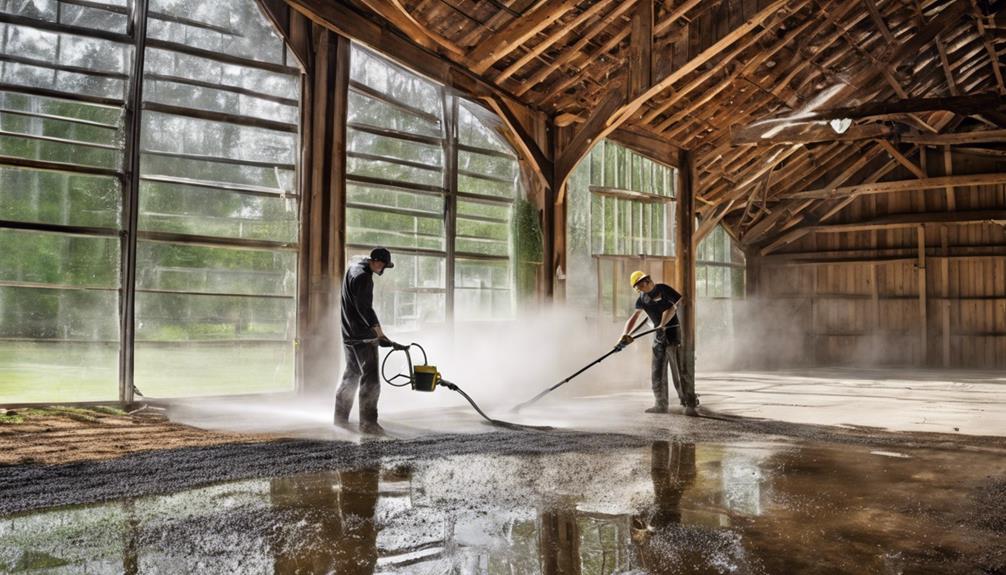
To maintain the structural integrity and longevity of our pole barn, implementing proper cleaning techniques is essential. Proper cleaning techniques not only enhance the appearance of the barn but also prevent wear and tear that can compromise its durability.
Here are some key strategies to ensure effective cleaning:
- Utilize Specialized Cleaners: Using specialized cleaners is crucial for removing dirt, grime, and other contaminants without damaging the surfaces of the pole barn.
- Focus on Soffit Vents: Cleaning soffit vents regularly is imperative to prevent blockages that can impact ventilation and lead to moisture issues.
- Address Wear and Tear: Regular cleaning helps identify areas of wear and tear early, allowing for prompt repairs and maintenance to prevent further damage.
- Thorough Roof and Wall Cleaning: Strong detergents should be used to ensure thorough cleaning of roofs and walls, preventing the build-up of debris that can accelerate deterioration.
- Preserve Structural Integrity: Regular cleaning is mandatory for all metal buildings to preserve their structural integrity, preventing rust, corrosion, and extending the lifespan of the pole barn.
Addressing Rust and Corrosion
Addressing rust and corrosion in pole barns requires vigilant maintenance practices to safeguard the structural integrity and longevity of the structure. Rust and corrosion, if left unchecked, can cause significant structural damage to pole barns over time. Regular inspections are crucial for early detection of rust, allowing for prompt intervention to prevent its spread.
To make your pole barn more resistant to corrosion, consider applying rust inhibitors or protective coatings to vulnerable areas. These measures not only manage existing corrosion but also prevent future rust formation. By addressing rust promptly and effectively, you can extend the lifespan of your pole barn and reduce overall maintenance costs.
Implementing rust prevention strategies is essential for ensuring the durability and longevity of pole barns. Stay proactive in managing rust and corrosion to maximize the functionality and lifespan of your pole barn.
Effective Painting and Coating
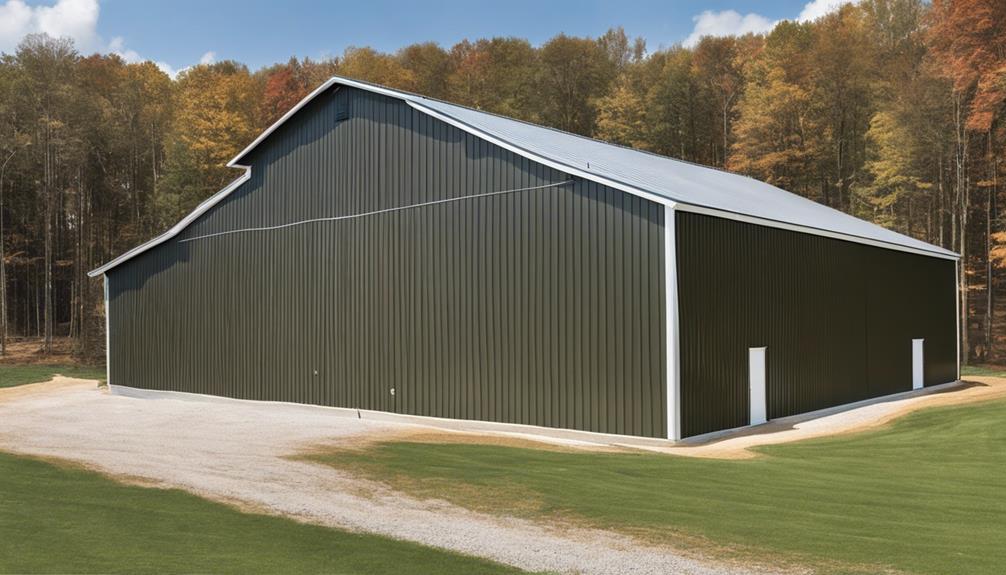
Vigilant maintenance practices, such as implementing effective painting and coating solutions, are essential for maximizing the durability and longevity of pole barns. Properly painting and coating your pole barn offers numerous benefits:
- Longevity Extension: Quality paint and coatings shield the structure from weathering and corrosion, extending its lifespan.
- Enhanced Aesthetics: Premium coatings not only protect but also enhance the visual appeal of your pole barn.
- Rust Prevention: Regular applications of protective coatings act as a barrier against rust and deterioration, preserving the building's integrity.
- Optimal Protection: Selecting the right paint and coating products designed for metal surfaces ensures maximum defense against UV rays and moisture.
- Cost Savings: Effective painting and coating maintenance can save you money by preventing costly repairs and prolonging the overall lifespan of your pole barn.
Structural Maintenance and Repairs
Regular inspections are crucial to detect rust, corrosion, and structural issues in a pole barn. Timely repairs of any damages or wear and tear are essential to prevent further deterioration and extend the structure's lifespan.
Ensuring proper maintenance of joints, connections, and roofing materials is vital for maintaining structural stability and longevity.
Inspecting for Damage
Inspecting a pole barn for structural damage is a critical task in ensuring its longevity and integrity. Regular inspections are key to identifying issues early on, preventing further deterioration.
Addressing rust spots promptly is essential to maintain the pole barn's integrity. Structural maintenance involves checking joints, connections, and supports for any signs of wear that could compromise the structure.
Seeking professional assessments can provide a deeper insight into the extent of damage and the necessary repairs needed for optimal structural integrity. By staying proactive and vigilant in our inspections, we can detect and address potential problems before they escalate, ultimately maximizing the life expectancy of the pole barn.
Timely Repairs Done
To ensure the structural integrity and longevity of a pole barn, timely repairs and maintenance are imperative. Addressing issues promptly prevents minor structural problems from escalating into major concerns that could compromise the entire building.
Regular maintenance not only sustains the structural integrity of the pole barn but also extends its life expectancy. Proper repairs play a crucial role in preventing costly damage over time.
By promptly addressing structural issues, we actively contribute to preserving the longevity of the pole barn and ensuring its continued functionality.
Emphasizing timely repairs and maintenance is key to maximizing the life expectancy of the pole barn and avoiding unnecessary expenses associated with neglecting structural upkeep.
Energy-Efficient Lighting Solutions
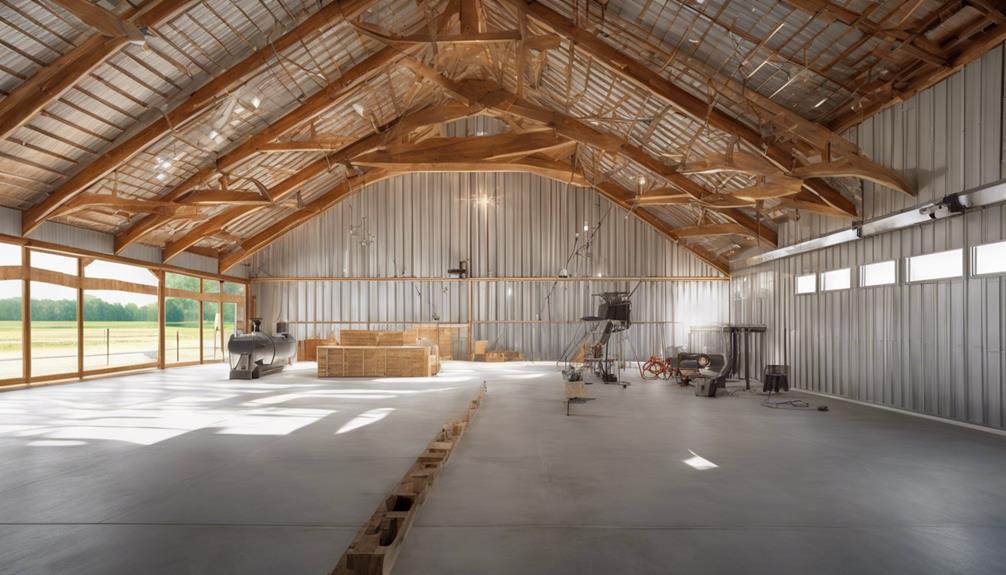
Utilizing linear LED high bay lighting in pole barn structures offers a highly energy-efficient solution, significantly reducing power consumption. When considering energy-efficient lighting solutions for your pole barn, here are some innovative options to maximize efficiency:
- UFO lighting: These options not only maximize space utilization but also deliver superior visibility, redefining how space is used within the structure.
- Occupancy sensor systems: These systems adjust light levels based on occupancy, optimizing energy consumption and contributing to sustainability efforts.
- Insulation overhaul: Ensuring proper insulation for climate control can maintain a consistent and comfortable environment, providing benefits like thermal efficiency and sound insulation.
- Smart technology integration: By incorporating smart technology, you can revolutionize management and functionality, optimizing resource usage and minimizing manual intervention.
Insulation for Climate Control
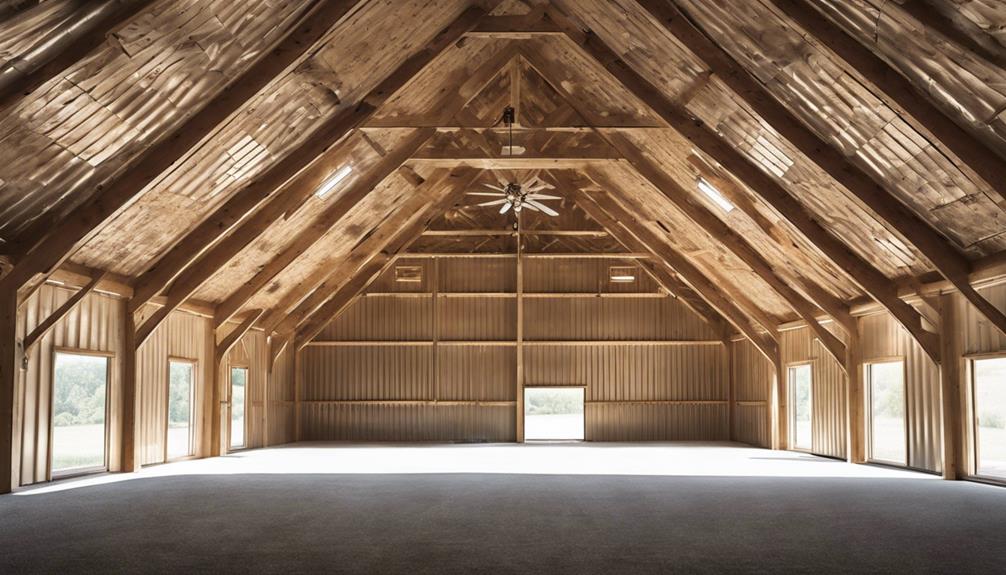
When considering energy-efficient lighting solutions for your pole barn, our focus shifts to the critical aspect of insulation for maintaining optimal climate control within the structure. Proper insulation plays a vital role in regulating internal temperatures efficiently, ensuring a consistent and comfortable environment for occupants. It offers unique benefits such as thermal efficiency and sound insulation, contributing to heightened energy efficiency and long-term cost savings on energy bills. Investing in quality insulation materials not only helps in maintaining a controlled climate inside the pole barn but also enhances the building's structural integrity by providing a barrier against external temperature fluctuations. This ensures that the pole barn remains energy-efficient and comfortable throughout the year.
| Benefits of Insulation | Description | Importance |
|---|---|---|
| Thermal Efficiency | Reduces heat transfer, keeping the interior warm in winter and cool in summer. | Energy conservation |
| Sound Insulation | Minimizes noise from outside and within the structure, creating a quieter workspace. | Enhanced comfort |
| Cost Savings | Lower energy bills due to reduced heating and cooling demands. | Financial efficiency |
Smart Technology Integration
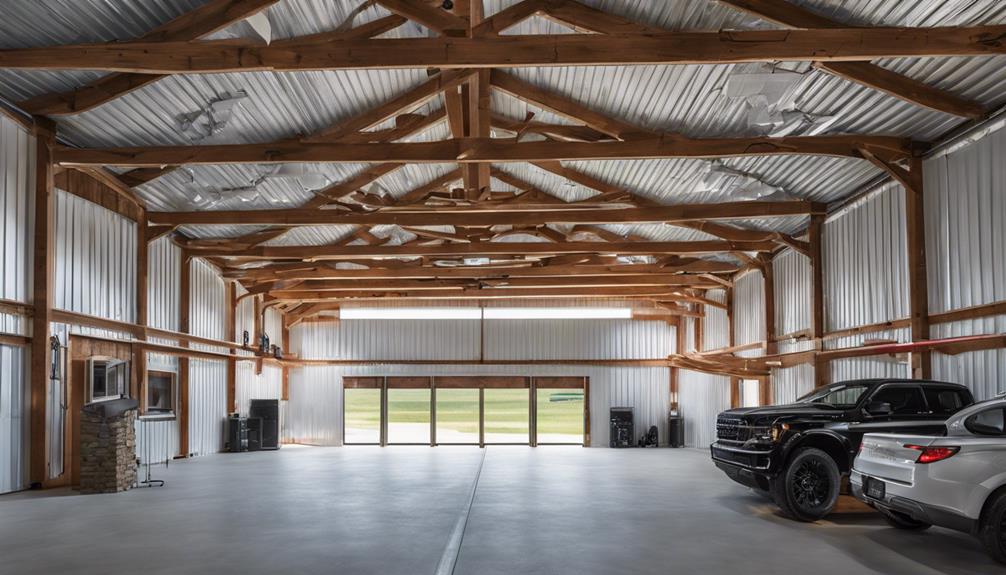
Smart technology integration enhances operational efficiency and functionality within pole barns by revolutionizing management processes through automated systems. With the incorporation of smart technology, a myriad of benefits can be realized:
- Seamless Control: Smart technology enables easy control of lighting, security, and climate systems, allowing for remote monitoring and accessibility.
- Resource Optimization: Automation through smart technology optimizes resource usage, reduces manual intervention, and boosts overall efficiency.
- Proactive Maintenance: Remote monitoring capabilities facilitate proactive maintenance and timely interventions, preventing potential issues.
- Energy Efficiency: Automation of systems ensures energy efficiency, leading to cost-effectiveness and streamlined operations.
- Enhanced Security: Smart technology integration provides enhanced security features, safeguarding assets within the pole barn.
Winter Weather Protection Strategies
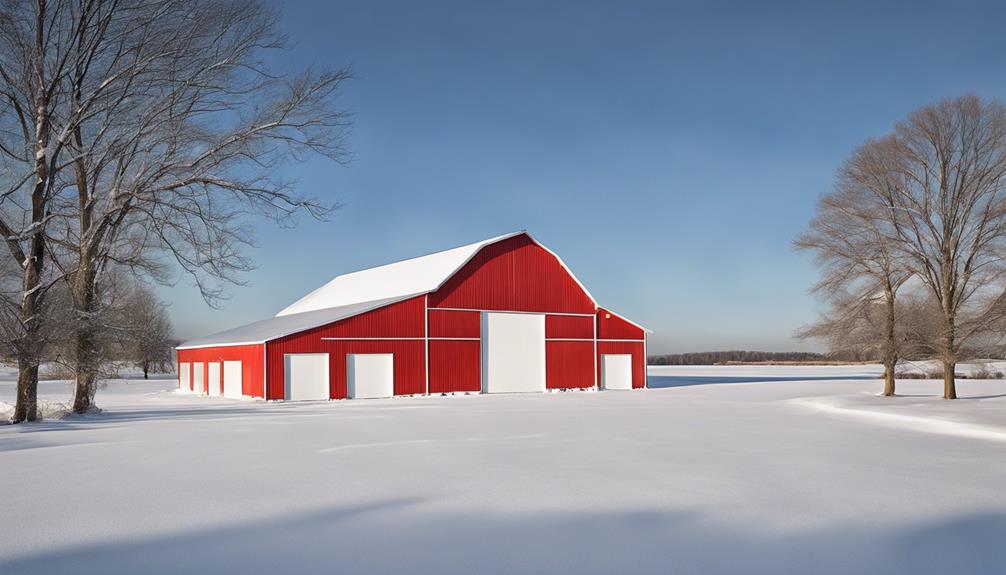
When it comes to winter weather protection strategies for pole barns, addressing roof snow removal, insulation tips, and ice dam prevention are crucial. Properly clearing snow off the roof and implementing adequate insulation can prevent structural issues caused by heavy snow loads.
Additionally, taking steps to prevent ice dams through proper ventilation and insulation practices is essential in maintaining the longevity of the pole barn.
Roof Snow Removal
To effectively protect a pole barn from structural damage due to excessive snow loads, proper roof snow removal strategies must be implemented. Snow accumulation can lead to roof collapse, jeopardizing the building's integrity. Utilizing snow bars and drainage systems helps prevent sudden snow avalanches, safeguarding the barn. Following construction building codes for snow load requirements ensures the roof can withstand harsh winter conditions. Regularly clearing snow from the roof is crucial to maintaining the pole barn's structural integrity and extending its lifespan.
- Implement snow bars and drainage systems
- Follow construction building codes for snow load requirements
- Regularly clear snow from the roof
- Prevent sudden snow avalanches
- Maintain structural integrity of the pole barn
Insulation Tips
Our approach to maximizing pole barn longevity in winter involves strategic insulation to regulate internal temperatures effectively. Proper insulation not only maintains a consistent and comfortable environment but also offers unique benefits such as thermal efficiency and sound insulation, contributing to heightened energy efficiency. Using quality insulation materials can lead to long-term cost savings by reducing heating expenses during colder months. An insulation overhaul in pole barns helps prevent heat loss, maintain structural integrity, and protect against extreme winter weather conditions. Well-insulated pole barns are better equipped to withstand harsh winter elements, ensuring the longevity and durability of the structure.
| Insulation Benefits | Description |
|---|---|
| Thermal Efficiency | Maintains consistent internal temperatures |
| Sound Insulation | Reduces noise transmission within the structure |
| Energy Efficiency | Decreases heating costs in colder months |
| Structural Integrity | Helps maintain the overall strength of the barn |
Ice Dam Prevention
Upon encountering the challenges posed by ice dams in winter, our focus shifts to implementing effective strategies for preventing structural damage and leaks in pole barns. To safeguard your pole barn, consider the following innovative approaches:
- Ensure proper insulation to maintain consistent roof temperatures.
- Address attic bypasses to prevent warm air leakage.
- Install roof/soffit vents for adequate ventilation and temperature control.
- Manage snow load to minimize the risk of roof stress.
- Deploy snow bars to prevent sudden snow avalanches.
Year-Round Maintenance Practices
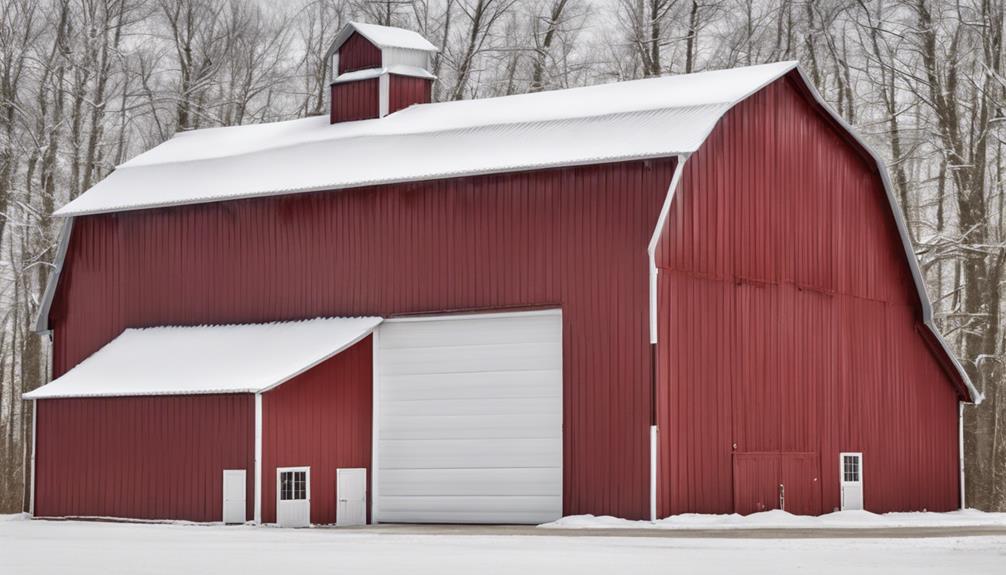
Ensuring consistent year-round maintenance practices is crucial for preserving the functionality and durability of your pole barn. Conducting timely repairs of small issues is paramount to maintaining the structural integrity of the building. Neglecting maintenance can result in serious structural damage, leading to costly repairs and rendering the pole barn unusable. By implementing regular maintenance practices throughout the year, you can significantly prolong the lifespan of your pole barn.
To maximize the life expectancy of your pole barn, it's essential to incorporate a comprehensive maintenance schedule. This schedule should include tasks such as inspecting the roof for leaks, checking the foundation for any signs of deterioration, and ensuring that the siding is intact and properly sealed. Additionally, it's important to regularly inspect and maintain the doors, windows, and ventilation systems to prevent moisture buildup and ensure proper airflow within the structure.
Frequently Asked Questions
How Do You Strengthen a Pole Barn?
To strengthen a pole barn, we reinforce key components like trusses, purlins, and footers to boost load-bearing capacity. Proper bracing techniques, including cross-bracing, enhance stability and durability.
Upgrading to higher-grade lumber and fasteners increases overall strength and resistance to structural stress. Incorporating diagonal wind bracing and roof truss bracing minimizes damage risks from high winds and severe weather.
Regular maintenance, like inspecting and replacing damaged parts, is crucial for long-term strength and integrity.
How Do You Keep Pole Barns From Rotting?
To prevent pole barns from rotting, we treat and seal wood components, inspect for water damage, ensure proper ventilation, use rot-resistant materials, and address foundation and drainage issues. These proactive measures combat moisture and decay, extending the structure's lifespan.
Regular maintenance and strategic construction choices are key to preserving the integrity of pole barns and maximizing their longevity.
What Is the Life Expectancy of a Pole Barn?
When it comes to the life expectancy of a pole barn, several factors come into play. From materials and construction quality to maintenance practices, the range can vary significantly.
Understanding these elements enables us to make informed decisions for preserving the structural integrity of our pole barns. By discussing the lifespan of these structures, we can proactively address issues and enhance their durability.
It's all about maximizing longevity through knowledge and action.
How Far Can You Span a Pole Barn?
We can span a pole barn up to 100 feet without support posts, depending on factors like roof slope, snow loads, and materials used. Clear-span designs provide uninterrupted space for storage, workshops, or agricultural needs.
Engineering calculations are vital for ensuring structural integrity and safety. Professional consultation is recommended for assessing specific requirements and limitations.
Ultimately, the span of a pole barn is influenced by various design and construction considerations.
Conclusion
In conclusion, maximizing the life expectancy of your pole barn requires consistent maintenance and proactive care. By staying ahead of issues such as rust, insulation, and structural maintenance, you can ensure the longevity of your building.
For example, by conducting regular inspections, a pole barn owner discovered a small leak in the roof early on, preventing costly water damage and structural issues down the line.
Overall, investing in proper upkeep will pay off in the long run.
- About the Author
- Latest Posts
Introducing Ron, the home decor aficionado at ByRetreat, whose passion for creating beautiful and inviting spaces is at the heart of his work. With his deep knowledge of home decor and his innate sense of style, Ron brings a wealth of expertise and a keen eye for detail to the ByRetreat team.
Ron’s love for home decor goes beyond aesthetics; he understands that our surroundings play a significant role in our overall well-being and productivity. With this in mind, Ron is dedicated to transforming remote workspaces into havens of comfort, functionality, and beauty.
-

 Vetted6 days ago
Vetted6 days ago15 Best Drip Irrigation Systems to Keep Your Garden Thriving
-

 Vetted2 days ago
Vetted2 days ago15 Best Dish Scrubbers to Keep Your Kitchen Sparkling Clean
-

 Beginners Guides2 weeks ago
Beginners Guides2 weeks agoDesigning Your Retreat Center – Essential Tips
-
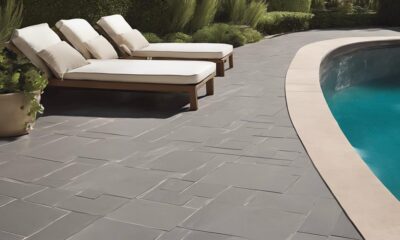
 Vetted3 weeks ago
Vetted3 weeks ago15 Best Tile Adhesives for Outdoor Use – Top Picks for Durable and Weather-Resistant Installations
-

 Beginners Guides2 weeks ago
Beginners Guides2 weeks agoAre Retreats Profitable
-

 Decor2 days ago
Decor2 days agoWhat Is Eclectic Home Decor
-
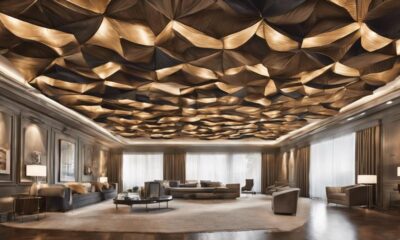
 Vetted2 weeks ago
Vetted2 weeks ago15 Creative Ways to Cover Up Popcorn Ceilings and Transform Your Space
-
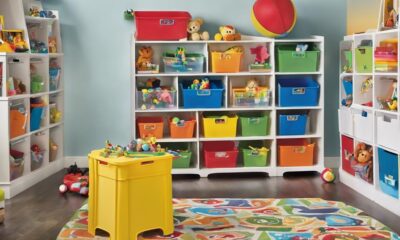
 Vetted2 weeks ago
Vetted2 weeks ago15 Best Playroom Storage Solutions to Keep Your Kids' Space Organized and Fun





